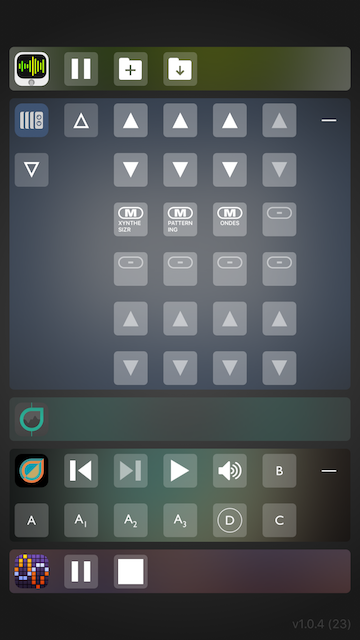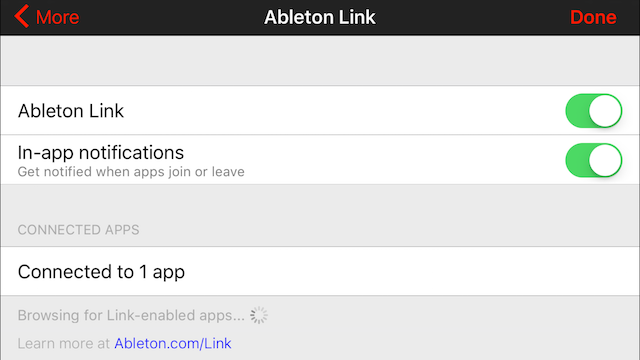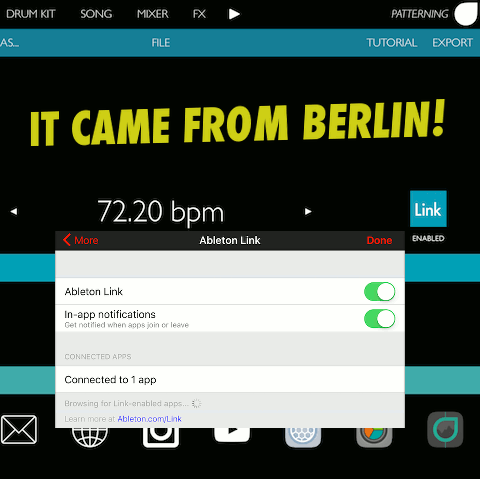iOS Music 2015: Multi-device Interaction
24 Dec 2015
2015 brought some big enhancements to the iOS music ecosystem, particularly for enabling performances with multiple devices.
Of course, there were some great instrument app releases, too. Patterning, the innovative drum machine from Olympia Noise Co, and Fugue Machine, a multi-playhead sequencer by Alexandernaut, stand out as important iOS instruments for the year. And there was the long-awaited release of Auria Pro that brings some competition to Cubasis for the top spot among iOS DAWs.
Along with Patterning, Fugue Machine and Auria Pro were big app releases for iOS in 2015.
But the most interesting developments from my perspective came from Audiobus and Ableton with both outfits releasing technology allowing multiple iOS devices to interact with one another wirelessly.
Audiobus Remote extends the utility of Audiobus and is part of the multi-device story for iOS music this year.
The folks from Audiobus have been stalwart players on the iOS music scene with their audio routing utility, also called Audiobus, which has become the defacto standard technology (still edging out Apple's IAA routing in terms of overall flexibility) for routing audio between apps on an iOS device. This year saw them release an Audiobus extension app called Audiobus Remote, which uses Bluetooth LE to allow one iOS device to serve as a control center for Audiobus running on another. The remote lets you do app switching on a target device, which is really handy because it lets you move between different applications on the device you're performing with without having to fiddle around with the Audiobus task bar. It's certainly possible to navigate between apps with the task bar but it's pretty challenging to seamlessly switch between instruments and effects when you're concentrating on being musical. Having recently switched from Android to iPhone, I've found Audiobus Remote to be a great addition to my setup.
The more powerful and interesting feature, however, is support for remote triggers, which enables apps to extend the control panel with custom behaviors that can be triggered remotely. You can see a list of apps that support remote triggers at the Audiobus site, which has a really nice search page that lets you search apps by capability (like remote triggers). Remote triggers let you launch samples, mute tracks, change levels and control other aspects of your applications' behaviors all from the remote! Where the initial release of Audiobus brought multi-app integration between music apps on a single device, Audiobus Remote brings us multi-device integration, where the applications on one device can be controlled by another.
 App-specific triggers in Audiobus Remote expose customized controls. For example, Mimix exposes track level and mute controls while Patterning allows launching song patterns.
App-specific triggers in Audiobus Remote expose customized controls. For example, Mimix exposes track level and mute controls while Patterning allows launching song patterns.
Audiobus Remote adds to the utility of Audiobus as a signal routing and app integration platform, and it's a key contribution in the move to multi-device in 2015. The other big contribution, brought to us by Ableton, makers of Live, is a nascent technology called Link, which lets multiple iOS devices on the same network stay in time with each other and control tempo. Live also supports Link (it's the only DAW to support it) though you don't need Live to use Link on iOS, which is nice because a quite a few iOS apps, including Audiobus, already support Link and more are on the way. (To see a list of Link-enabled apps head over to the Audiobus apps page or you can check out Ableton's Link page.)
 Link makes it trivial to jam with other devices on a network and stay in sync.
Link makes it trivial to jam with other devices on a network and stay in sync.
Link is a landmark technology because it makes it trivial for users on the same network to make music with their iOS devices. There's no need to configure clock settings or MIDI ports; you simply turn Link on in an app and it auto discovers other Link-enabled apps on the network. (It works equally well for apps running on the same device.) Also, with Link there's no master device controlling tempo. Any device participating in a Link session can update the tempo with last-write-wins semantics. Which is to say, whichever device changes the tempo most recently "wins" and its tempo is used as the tempo for the session. You can read more about Link in the FAQ on Ableton's site or over at CDM.
 Link, a technology that enables iOS devices to sync tempo wirelessly, gets Ableton into the mobile game in a big way and ends 2015 on an innovative note for iOS music.
Link, a technology that enables iOS devices to sync tempo wirelessly, gets Ableton into the mobile game in a big way and ends 2015 on an innovative note for iOS music.
As Link was just released this month, it will be interesting to see how it influences iOS music software in the coming year. It's also interesting to see the investment in mobile/iOS from Ableton. With the recent launch of Cubase 8.5 including VST Transit, a cloud collaboration platform built directly into Cubase, Steinberg forays into Internet technology, complementing their move to mobile with Cubasis. Now Ableton gets into the mobile game in a big way with Link. I think 2016 will continue to bring mobile, Internet, and music technologies together in innovative ways, and it'll be great to see how musicians experiment with and explore the creative possibilities these technologies enable.